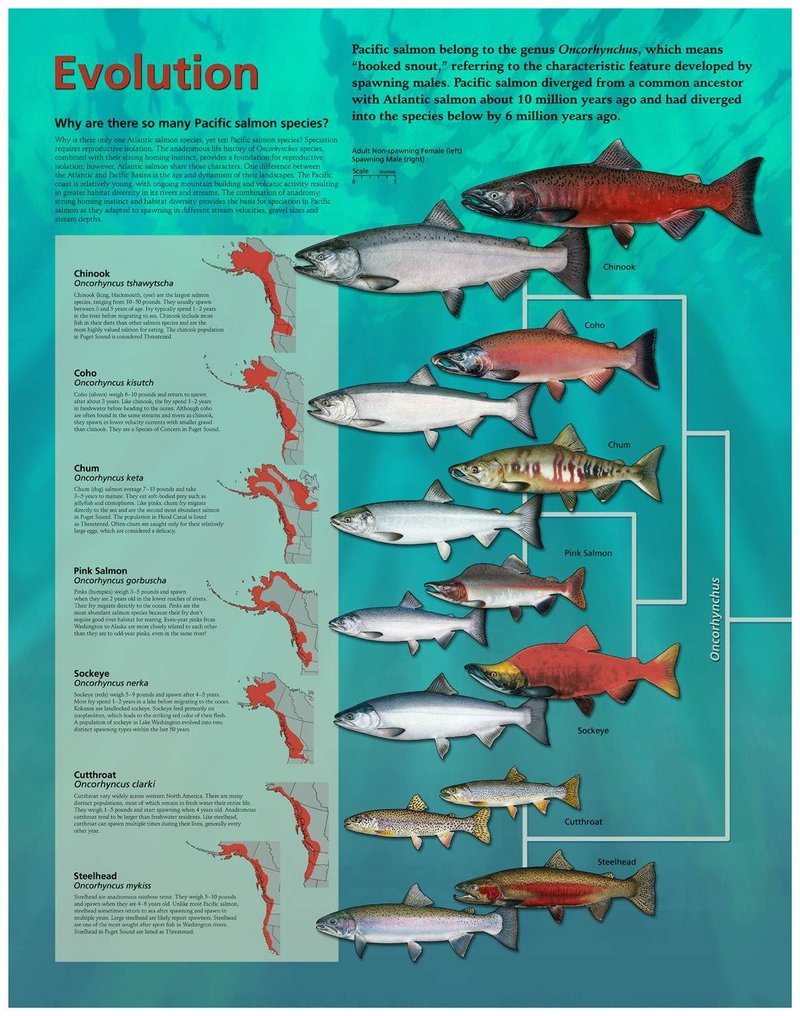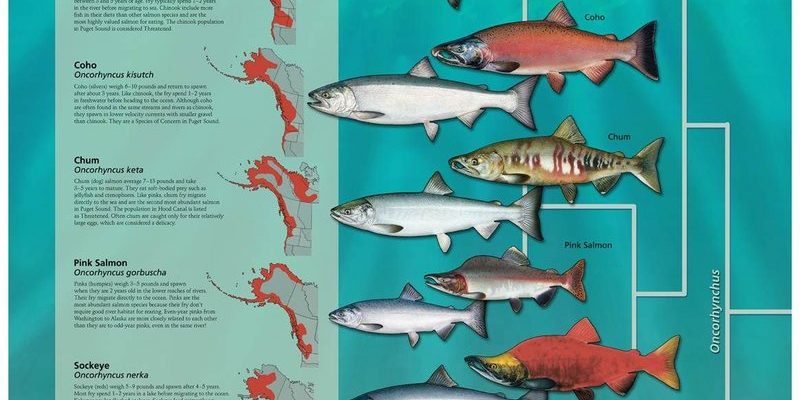
Let’s take a closer look at the fascinating evolutionary history of the salmon. These fish have been around for millions of years, showcasing a remarkable story of adaptation and survival. This exploration will uncover the salmon’s ancestors, their environment, and how they have evolved, giving you a deeper appreciation for your fishing adventures or the salmon fillet on your dinner plate.
The Ancestry of Salmon: Where it All Began
To understand the evolutionary history of the salmon, we need to travel back in time—way back, to around 60 million years ago. During this period, the ancestors of modern salmon began to diverge from other fish species. Here’s the thing: salmon are part of the family Salmonidae, which also includes trout and char. This family branched from their relatives due to geographical changes and adaptations to different environments.
Salmon originated in the cold waters of the Northern Hemisphere. Over time, they developed specific traits to thrive in these conditions. They became optimized for both freshwater and saltwater environments, a feat that few fish can pull off. This dual adaptability is one of the key traits that define salmon today. Imagine being able to live in two different worlds effortlessly; that’s what salmon do!
As salmon evolved, they adapted to their habitats in various ways. Their bodies became streamlined for swimming, allowing them to navigate rivers and oceans with grace. They developed specialized gills, enabling them to extract oxygen from both freshwater and saltwater. This evolutionary flexibility is essential for their life cycle, which often involves migrating between these two environments as they grow and reproduce.
The Different Species: A Diverse Family
Not all salmon are created equal! There are several species of salmon, each with unique traits and historical backgrounds. The most well-known species include the Chinook, Coho, Sockeye, Pink, and Chum. Each of these salmon varieties has its own story shaped by evolutionary pressures and the environments they inhabit.
Let’s start with the Chinook salmon, also known as King salmon. They are the largest of the salmon species and are highly valued for their rich flavor and high oil content. This species thrives in the Pacific Ocean and prefers deeper, cooler waters. Their impressive size and taste make them a sought-after catch—not just for fishing enthusiasts but also for culinary lovers.
Then, there’s the Sockeye salmon, famous for its vibrant red color and delicious taste. This species has adapted to spawning in lakes and rivers, showcasing a unique life cycle that includes a dramatic color change as they transition from saltwater to freshwater. This remarkable transformation is a striking visual and serves as a strong biological signal to potential mates.
In contrast, Pink salmon, the smallest species, are known for their milder flavor. They have a two-year life cycle, which is quite different from many other salmon species. This shorter lifecycle allows for rapid population growth, but it also makes them more vulnerable to environmental changes. Each salmon species plays a vital role in its ecosystem, helping to maintain balance in their environments.
Migration: The Epic Journey
One of the most captivating aspects of salmon is their incredible migration journey. Salmon are known for their remarkable ability to travel thousands of miles from the ocean back to their freshwater spawning grounds. This migration isn’t just a casual swim; it’s an epic quest filled with challenges and dangers.
Salmon begin their lives in freshwater rivers, where they hatch from eggs. After a short period, they move to the ocean, where they grow and develop for a few years. In adulthood, they make an instinctual journey back to their birthplace to spawn. It’s like a powerful internal compass guiding them home.
This journey is both physically demanding and perilous. Salmon face numerous obstacles, including predators, waterfalls, and human-made barriers like dams. Still, their determination is truly inspiring. The migration process ensures genetic diversity and the health of salmon populations, while also giving us those spectacular images of fish leaping through waterfalls.
Moreover, their migration plays a crucial role in the ecosystem. As they travel upstream, they transport nutrients vital for the aquatic and terrestrial ecosystems, enriching the environments where they spawn. This natural process highlights how interconnected life can be and the importance of every species in maintaining ecological balance.
Environmental Changes and Adaptations
The evolutionary history of the salmon doesn’t stop at migration; it’s also heavily influenced by environmental changes. Over millions of years, salmon have faced challenges such as climate change, habitat destruction, and changing ocean conditions. Each of these factors has pushed salmon to adapt, shaping their evolution and survival.
Climate change is a major concern today. Rising water temperatures and altered river flows can drastically affect salmon habitats. Salmon are sensitive to temperature changes, and warmer waters can impact their breeding and survival rates. Some species are now migrating earlier to adapt to these changes, showcasing their resilience and ability to adjust to new environmental conditions.
Habitat destruction is another significant challenge. Dams blocking rivers can hinder migration, leading to declining populations. Conservation efforts focus on restoring natural habitats and ensuring that fish can navigate freely between their ocean and freshwater homes. Efforts like building fish ladders help salmon bypass obstacles, allowing them to complete their migratory journeys.
Moreover, as humans continue to impact the environment through pollution and overfishing, the evolutionary pressures on salmon are becoming more pronounced. It raises questions about sustainability and the future of these magnificent creatures, prompting discussions on how we can protect them for generations to come.
The Cultural Significance of Salmon
Beyond their biological and ecological importance, salmon hold significant cultural value for many communities worldwide. Indigenous peoples of the Pacific Northwest, for example, view salmon as a vital part of their culture, history, and identity. Salmon are not just a food source; they represent a connection to the land, water, and community.
Fishing traditions have developed around salmon over centuries. Many cultural practices celebrate the salmon’s return, showcasing deep respect for these creatures and their role in the ecosystem. Festivals and communal fishing events often take place, emphasizing the importance of this fish not only as sustenance but also as a symbol of resilience and renewal.
In more modern settings, salmon continues to be a crucial part of culinary traditions, appearing in various dishes and cuisines. From sushi to smoked salmon platters, this fish has transcended its biological roots to become an integral part of social gatherings and celebrations.
The love for salmon extends to conservation efforts as well. Many communities and organizations work tirelessly to protect salmon populations and their habitats. This cultural reverence for salmon plays a pivotal role in conservation strategies, reminding us that protecting these fish goes hand in hand with preserving cultural heritage.
Future Considerations: What Lies Ahead for Salmon?
Looking ahead, what does the future hold for salmon? It’s a complex question with many factors at play. As we’ve seen, salmon face numerous challenges, from changing climates to habitat loss. However, with ongoing research and conservation efforts, there’s hope for these iconic fish.
Scientists are studying salmon populations to better understand their needs and the impacts of environmental changes. This research is vital for creating effective conservation strategies that adapt to current challenges. By working together, communities, scientists, and policymakers can develop a balanced approach that secures the future of salmon habitats.
Additionally, sustainable fishing practices are becoming increasingly important. As we strive to enjoy the bounty of the ocean, it’s crucial to remember that responsible fishing ensures our seafood choices do not threaten salmon populations. People are encouraged to support sustainably sourced salmon, contributing to the health of both fisheries and the environment.
In summary, the evolutionary history of salmon is a tale of resilience, adaptability, and connection. As we continue to explore and understand their story, we can appreciate these remarkable fish that have thrived through centuries of change. With dedication and care, we can ensure that future generations can enjoy the wonders of salmon, both in nature and on our plates.

